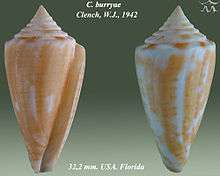Conus burryae
Conus burryae, common name Mrs Burry's cone, is a species of sea snail, a marine gastropod mollusk in the family Conidae, the cone snails and their allies.[1][2]
| Conus burryae | |
|---|---|
 | |
| Apertural and abapertural views of shell of Conus burryae" Clench, W.J., 1942 | |
 | |
| Scientific classification | |
| Kingdom: | Animalia |
| Phylum: | Mollusca |
| Class: | Gastropoda |
| Clade: | Caenogastropoda |
| Clade: | Hypsogastropoda |
| Clade: | Neogastropoda |
| Superfamily: | Conoidea |
| Family: | Conidae |
| Genus: | Conus |
| Species: | C. burryae |
| Binomial name | |
| Conus burryae Clench, 1942 | |
| Synonyms[1] | |
| |
Like all species within the genus Conus, these snails are predatory and venomous. They are capable of "stinging" humans, therefore live ones should be handled carefully or not at all.
Description
The size of the shell varies between 20 mm and 35 mm.
Distribution
This species occurs in the Gulf of Mexico.
Notes
- Conus burryae Clench, 1942. Retrieved through: World Register of Marine Species on 4 April 2012.
- Rosenberg, G., F. Moretzsohn, and E. F. García. 2009. Gastropoda (Mollusca) of the Gulf of Mexico, Pp. 579–699 in Felder, D.L. and D.K. Camp (eds.), Gulf of Mexico–Origins, Waters, and Biota. Biodiversity. Texas A&M Press, College Station, Texas.
gollark: I don't think krist would be a good idea. We would tie currency here to Switchcraft.
gollark: <@113673208296636420> I'm not sure if it'll transfer your progress.
gollark: <@671141644241862667> Your server is unhappy with me flying even though Psi allows it noncheatily.
gollark: Excellent.
gollark: <@113673208296636420> test.
References
- Clench, W. J. 1942. The Genus Conus in the Western Atlantic. Johnsonia 1(6): 1–40.
- Filmer R.M. (2001). A Catalogue of Nomenclature and Taxonomy in the Living Conidae 1758 - 1998. Backhuys Publishers, Leiden. 388pp.
- Tucker J.K. (2009). Recent cone species database. 4 September 2009 Edition
- Rosenberg, G., F. Moretzsohn, and E. F. García. 2009. Gastropoda (Mollusca) of the Gulf of Mexico, Pp. 579–699 in Felder, D.L. and D.K. Camp (eds.), Gulf of Mexico–Origins, Waters, and Biota. Biodiversity. Texas A&M Press, College Station, Texas.
- Petuch E.J. & Sargent D.M. (2011) New species of Conidae and Conilithidae (Gastropoda) from the tropical Americas and Philippines. With notes on some poorly-known Floridian species. Visaya 3(3): 37–58.
- Monnier E. & Limpalaër L. (2012) Dauciconus colombi (Gastropoda: Conidae), a new species from Martinique. Visaya 3(5): 15–19. [March 2012]
- Puillandre N., Duda T.F., Meyer C., Olivera B.M. & Bouchet P. (2015). One, four or 100 genera? A new classification of the cone snails. Journal of Molluscan Studies. 81: 1–23
External links
- The Conus Biodiversity website
- "Gradiconus anabathrum burryae". Gastropods.com. Retrieved 15 January 2019.
- Cone Shells – Knights of the Sea
This article is issued from Wikipedia. The text is licensed under Creative Commons - Attribution - Sharealike. Additional terms may apply for the media files.